Why do you need to fertilize your lawn?
A healthy and fast growing lawn needs a lot of energy and nutrition. The soil does provide some of it but soil and water alone cannot provide all the nutrients. So we need fertilizers for extra nutrition and healthy growth of a lawn.
Since every lawn is different with different climatic conditions, soil type and grass, landscaping companies have different types of fertilizers to fulfill the needs of every type of lawn.
Fertilizers help your lawn stay healthy by:
- Providing the right amount of all the nutrients
- Promoting the growth of new leaves and root
- Aiding recovery from foot traffic and pest damage
- Controlling and reducing weeds
How do you choose the right fertilizer?
While selecting the fertilizer for your lawn, you should focus on the following:
- Nitrogen, Phosphorus and Potassium are the main ingredients of a fertilizer. The 20-5-10 mixture is a good basic mix for spring.
- A slow-release fertilizer with the right amount of nitrogen is considered better. It breaks down the nutrients over a longer period of time, giving you a longer gap between applications.
- The type of grass, season and its growing period.
- The pH of the soil. Sometimes the regular mix of 20-5-10 may not be the best option due to pH imbalances in the lawn soil.
Steps for the proper application of fertilizers
- Fertilizing warm season grass
- Start fertilizing when the grass turns green in Spring.
- The growing season of this grass is late Spring and Summer when the temperature is between 80 to 95° Fahrenheit, although they also grow outside of this range.
- Use either slow or quick-release fertilizer, but schedule fertilization accordingly so the fertilizer is used before the onset of severe heat.
- Begin fertilizing again after the intense heat of the Summer has subsided.
- Fertilizing too much is not a good thing. Design a schedule for fertilization.
- Always follow the lawn care company’s instructions when fertilizing your lawn to avoid damage.
- Fertilizing cool season grass
- Fertilize heavily in the Fall and lightly in the early spring.
- The growing season of this grass is during the cool months of Spring and fall when the temperature is between 60 to 70° Fahrenheit.
- Fertilize when the intense heat has subsided, but well before the onset of severe cold weather.
- Since fall is the favorite time of year for cool season grasses, you may choose to apply a special winterizer fertilizer for the fall application. These fertilizers are specially-formulated to help protect the grass during the Winter months.
- In the Spring, begin fertilizing early. You may use either slow or quick-release but schedule fertilization accordingly so the fertilizer used before the onset of the hot Summer when cool-season grasses often go dormant.
- Fertilizing too much is not a good thing. Create a schedule for fertilization.
- Spraying liquid fertilizer
- Fill the sprayer canister with liquid fertilizer and carefully attach the canister unit to the end of your garden hose.
- Move at a steady pace to cover the entire lawn evenly.
- Spray from side to side.
- Do not apply other chemicals, such as herbicides or insecticides, at the same time as the fertilizer.
- Buy fertilizers only enough for the season. Leftover fertilizer does not store very well.
- Spreading granular fertilizer
- Make sure the spreader and the fertilizer is dry.
- Set the rate-of-flow lever according to the setting listed on the fertilizer bag. If you’re unsure either contact a lawn care company or apply less rather than more.
- Wear gloves and a dust mask and keep the fertilizer away from your eyes and skin.
- For complete coverage, cut the recommended application rate in half and apply evenly in a criss-cross manner.
- Clean the spreader thoroughly after use.
- Clean up any excess fertilizer from sidewalks and driveways.
The most important thing you can do for your lawn is to feed it well. A well-fed lawn is healthier, which means it has a better root system and resistance to combat heat, cold, drought, mowing, foot traffic and other stresses.
Tender Care Lawn Service is a family owned landscaping company established in 2004 in Sulphur, LA. Our land care services include lawn care, mosquito spraying, miniexcavator work, fertilization and weed control, sprinkler system programming and repair, shrub and hedge trimming, and landscape maintenance.


